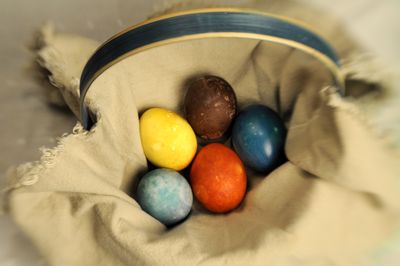Easter Bunny might raise a stink
Naturally dyed easter eggs sound great, but smell awful

Sometimes my job stinks.
My husband usually considers it an advantage to live with someone who writes about food and he’s usually game for experimentation. But a recent project left him shaking his head – and plugging his nose.
In an effort to write a story about coloring Easter eggs with natural dyes, I whipped together an array of concoctions from foods that promised PAAS-like hues without the familiar little tablets.
It would be fun. It would be natural. The boys will love it. Readers will love it, I thought.
But by the time the evening was over, we had boiled eggs, red cabbage, onion skins, spinach and created concoctions with vinegar, turmeric, acai juice, salt and chili powder.
I’m not sure if the boys just lost interest in the slow-moving magic, or if the stench drove them from the kitchen.
As we wiped down the counters and tucked the last batch of eggs and dye into the refrigerator that night, my husband shook his head and said, “We’ve done a bad, bad, bad thing in here tonight.”
The truth is, we did end up with some beautiful eggs: The eggs soaked in the cabbage water were a deep blue by morning, the onions yielded a surprising orange hue, turmeric gave the orbs a pretty sunshine effect and the berry juice turned eggshells a deep purple.
My advice? Just be sure you know what you’re getting into. Approach it like one of those gross-out science experiments instead of an art party.
Besides the P.U.-factor, there are other disadvantages: The food used to make the dyes goes to waste and the porous shell allows the flavors to permeate the eggs. Red cabbage eggs anyone?
Still want to try it? Here are the techniques that worked best for us, compiled from Web sites including marthastewart.com, stretcher.com and about.com. The recipes can be easily halved.
For the perfect hard-cooked egg: Place eggs in a single layer in a saucepan. Add enough water to come at least 1 inch above the eggs. Cover. Quickly bring just to boiling. Turn off heat and remove pan from heat. Let eggs stand, covered, about 12 minutes for medium eggs, 15 minutes for large eggs and 18 minutes for extra large. Then, immediately run cold water over eggs or place them in ice water until completely cooled. This helps avoid that greenish ring around the yolks.
For the best colors, Martha Stewart editor recommend wiping down each egg with vinegar to help the shells absorb the dyes.
Red Cabbage Eggs
Cook eggs. Boil 1 head red cabbage with 2 quarts water for 30 minutes. Strain cabbage water. Add 4 tablespoons salt and 4 tablespoons vinegar. Soak eggs in the bath 30 seconds to 1 minute for light blue color or overnight in the refrigerator for a deeper blue.
Turmeric Eggs
Cook eggs. Fill a pot with 2 quarts water and add 4 tablespoons salt, 4 tablespoons vinegar and 6 tablespoons turmeric. Lower eggs into bath. Remove when they reach desired color. For green eggs, swap turmeric and red cabbage eggs into opposite baths. (Boiling spinach to create a green dye didn’t work for us despite the recommendation in a couple of stories.) Place in the refrigerator if soaking overnight.
Onion Skin Eggs
Combine 2 quarts water, 2 quarts packed yellow onion skins, ¼ cup vinegar and ¼ cup salt. Soak precooked eggs overnight in the mixture. (We got a similar effect by boiling about 2 cups of onion skins in water for 20 minutes, then straining the onion water and soaking boiled eggs overnight in the fridge.) For sienna eggs, try red onion skins.
Coffee Eggs
Combine 2 quarts very strong coffee, add ¼ cup vinegar and ¼ cup salt. Lower cooked eggs into bath and let soak overnight.
Beet Eggs
Combine 8 cups water, 8 cups chopped beets, ¼ cup vinegar and ¼ cup salt. Lower eggs into bath and soak until they reach the desired color.
Try experimenting
Have fun experimenting with other colors and techniques. When our spinach green color failed, we put the eggs into the leftover red cabbage dye for about an hour and the egg shells took on a wonderful blue and green tie-dye effect.